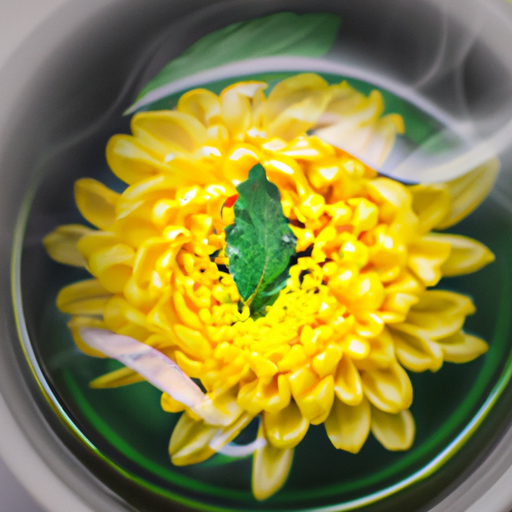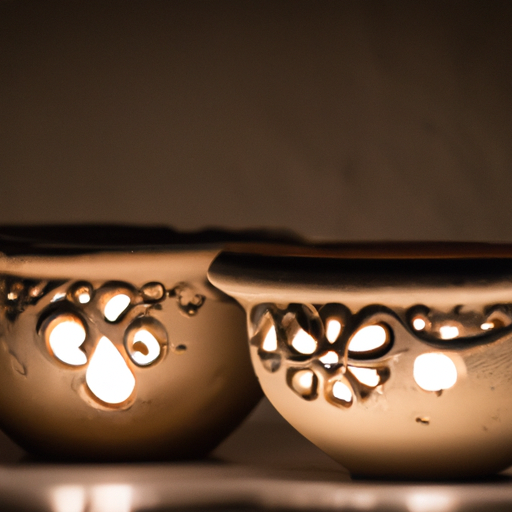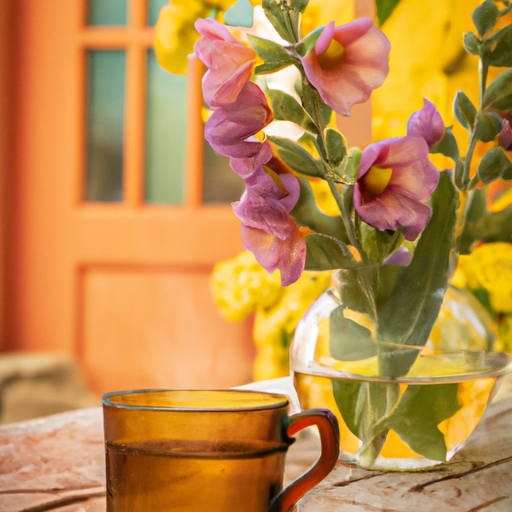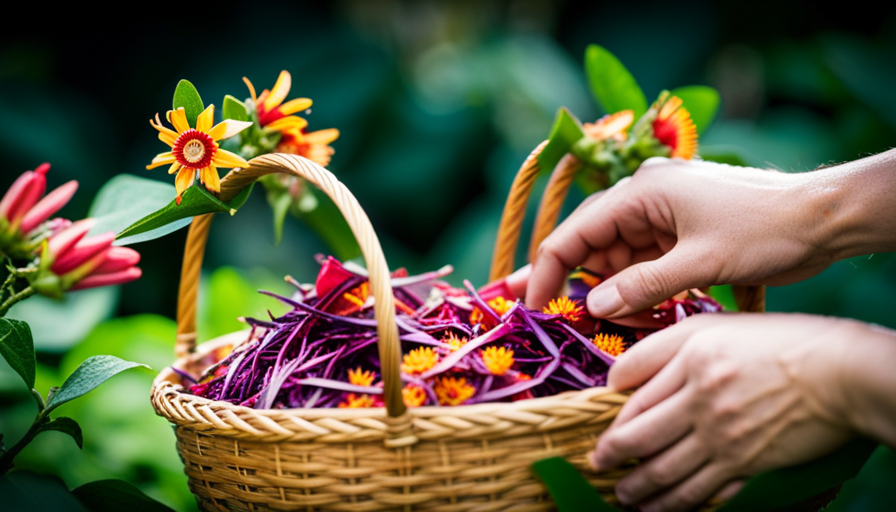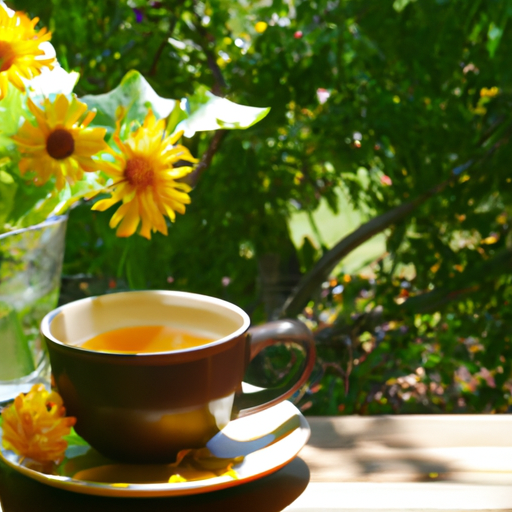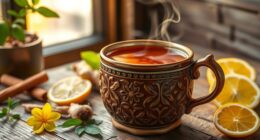When it comes to tea, the world is filled with a vast array of flavors and varieties.
One particular flower that has captivated tea enthusiasts for centuries is the chrysanthemum. With its delicate petals and vibrant colors, the chrysanthemum flower is not only a visual delight but also a source of aromatic and flavorful tea.
But which chrysanthemum flower is used for tea? Allow me to shed some light on this fascinating subject.
Amidst a sea of chrysanthemum species, the most commonly used for tea is the Chrysanthemum indicum, also known as the Indian Chrysanthemum. Its vibrant yellow petals and herbal scent make it a popular choice for tea enthusiasts seeking a soothing and refreshing brew. This particular variety is known for its numerous health benefits, including its ability to support the immune system and promote relaxation.
So, if you’re looking to explore the world of floral teas, join me as we dive into the captivating realm of chrysanthemum tea, where beauty meets flavor and wellness intertwines.
Key Takeaways
- The most commonly used chrysanthemum flower for tea is Chrysanthemum indicum.
- Chrysanthemum tea can be brewed with milk for a creamy texture and can aid in sleep.
- Chrysanthemum tea has cultural significance in China and is often served during important ceremonies and rituals.
- Chrysanthemum tea has benefits for heart health, inflammation, and digestion.
Different Varieties of Chrysanthemum Flowers
Did you know that there are numerous varieties of chrysanthemum flowers, each with its own unique characteristics and uses?
Chrysanthemum flowers have been used for centuries in traditional Chinese medicine and are well-known for their health benefits. One of the most popular uses of chrysanthemum flowers is in the making of chrysanthemum tea. This delicate and fragrant tea is known for its calming properties and is often consumed to promote relaxation and reduce anxiety.
There are several varieties of chrysanthemum flowers that are commonly used to make chrysanthemum tea. One of the most popular varieties is the white chrysanthemum flower, which is known for its mild and slightly sweet flavor. This variety is often used in combination with other herbs and flowers to create a soothing and aromatic tea blend.
Another variety of chrysanthemum flower that is used for tea is the yellow chrysanthemum. This variety has a slightly stronger flavor and is often used in herbal remedies to promote respiratory health. The yellow chrysanthemum is also known for its antioxidant properties, which can help to protect against cell damage and boost the immune system.
Chrysanthemum flowers come in a variety of flavors and each has its own unique benefits.
Now let’s explore the different flavors of chrysanthemum tea.
Flavors of Chrysanthemum Tea
Explore the delightful array of flavors that await you in a cup of chrysanthemum tea. This ancient beverage boasts a rich history and a wide range of flavors that cater to every palate. Here are three sub-lists that’ll grab your attention:
-
Floral Delights:
- Chrysanthemum flowers offer a delicate and floral flavor profile, reminiscent of springtime gardens.
- The tea has a subtle sweetness that’s both refreshing and soothing.
- The floral notes create a calming and tranquil experience, perfect for winding down after a long day.
-
Earthy Undertones:
- Chrysanthemum tea has a hint of earthiness, giving it a unique and grounding taste.
- The earthy undertones add depth to the tea, making it a satisfying and comforting beverage.
- This flavor profile is particularly enjoyable for those who prefer a more robust and aromatic cup of tea.
-
Herbal Infusions:
- Chrysanthemum tea often incorporates other herbs and ingredients, such as goji berries or honey, to enhance its flavor and health benefits.
- These herbal infusions create a harmonious blend of flavors, offering a well-rounded and nourishing tea experience.
- The combination of chrysanthemum and other herbs provides a multitude of health benefits, making it a popular choice for those seeking wellness through their tea.
Delve into the next section to discover the numerous health benefits of chrysanthemum tea that accompany these delightful flavors.
Health Benefits of Chrysanthemum Tea
Indulging in a cup of chrysanthemum tea can provide you with a variety of health benefits, such as boosting your immune system and promoting relaxation, making it an excellent addition to your wellness routine.
Chrysanthemum tea is not only a delicious beverage, but it also offers numerous potential health benefits. Research suggests that chrysanthemum tea may have anti-inflammatory properties, which can help reduce inflammation in the body and alleviate symptoms of certain conditions like arthritis. Additionally, this tea is rich in antioxidants, which can protect your cells from damage caused by harmful free radicals. Some studies have also shown that chrysanthemum tea may have antimicrobial properties, potentially helping to fight off certain infections.
However, it is important to note that chrysanthemum tea may not be suitable for everyone. Some individuals may experience allergic reactions to chrysanthemum, so it’s important to exercise caution if you have a known allergy. Pregnant women and those with certain medical conditions should also consult with their healthcare provider before consuming chrysanthemum tea.
Transitioning to the next section on brewing methods for chrysanthemum tea, it’s essential to understand the potential risks and contraindications associated with this herbal beverage.
Brewing Methods for Chrysanthemum Tea
To brew a delicious cup of chrysanthemum tea, simply steep the dried petals in hot water for a few minutes and enjoy the soothing and aromatic infusion. Here are four reasons why brewing chrysanthemum tea can be a delightful experience:
-
Indulgent Creaminess: For a unique twist, try brewing chrysanthemum tea with milk. The creamy texture of the milk complements the delicate floral notes of the tea, creating a rich and indulgent drink that’s both comforting and satisfying.
-
Sleep Aid: Chrysanthemum tea has been used for centuries in traditional Chinese medicine to promote relaxation and improve sleep quality. Its natural compounds, such as flavonoids and apigenin, have calming effects on the nervous system, helping to reduce anxiety and promote restful sleep.
-
Aromatherapy in a Cup: The aroma of chrysanthemum tea is subtle yet captivating. As you sip on this fragrant brew, the delicate floral notes gently waft through the air, creating a calming and serene atmosphere that can help you unwind after a long day.
-
Calming the Mind and Body: The act of brewing chrysanthemum tea can be a meditative experience. As you watch the dried petals dance in the hot water, the process of steeping becomes a moment of mindfulness, allowing you to slow down and find inner peace.
Transitioning into the next section, let’s explore the traditional and cultural significance of chrysanthemum tea.
Traditional and Cultural Significance of Chrysanthemum Tea
The cultural significance of chrysanthemum tea can be traced back to ancient China, where it was considered a symbol of longevity and rejuvenation. This delicate infusion has been an integral part of traditional Chinese brewing methods for centuries, and its consumption is deeply ingrained in various cultural ceremonies and rituals.
From formal tea ceremonies to everyday family gatherings, chrysanthemum tea holds a special place in Chinese culture. The brewing of chrysanthemum tea follows traditional methods that have been passed down through generations. The flowers are carefully selected and dried, then steeped in hot water to release their unique flavors and health benefits. This precise brewing process ensures that the tea retains its delicate floral aroma and therapeutic properties.
Chrysanthemum tea is often served during important cultural ceremonies and rituals in China. It is believed to cleanse the body and promote overall well-being. Whether it is a wedding, a birthday celebration, or a funeral, chrysanthemum tea is a staple beverage that symbolizes purity and harmony.
As we delve into the next section on where to buy chrysanthemum tea, it is important to understand the traditional and cultural significance of this beloved brew. With its rich history and its role in various ceremonies, chrysanthemum tea holds a special place in the hearts of many.
Where to Buy Chrysanthemum Tea
Chrysanthemum tea is not only a delicious beverage, but it also holds great cultural significance. As mentioned in the previous subtopic, chrysanthemum tea has been enjoyed for centuries in Asia for its various health benefits and calming properties.
Now, let’s explore where you can buy this delightful tea.
When it comes to purchasing chrysanthemum tea, there are several options available. You can find it at specialty tea shops, health food stores, and even online. To help you in your search, here are the best chrysanthemum tea brands to consider:
-
Teavivre: This brand offers high-quality chrysanthemum tea made from handpicked flowers, ensuring a rich and aromatic brew.
-
Ten Ren Tea: Known for their expertise in tea, Ten Ren Tea offers a wide selection of chrysanthemum teas, each with its own unique flavor profile.
-
The Tao of Tea: This brand specializes in organic teas, and their chrysanthemum tea is no exception. It is made from sustainably sourced flowers, resulting in a pure and refreshing taste.
-
Prince of Peace: With a focus on traditional Chinese herbal teas, Prince of Peace offers a chrysanthemum tea that is both fragrant and soothing.
Drinking chrysanthemum tea has numerous benefits, including improved heart health, reduced inflammation, and enhanced digestion. Now that we know where to find this delightful tea and its benefits, let’s delve into chrysanthemum tea recipes and pairings.
Chrysanthemum Tea Recipes and Pairings
I absolutely love experimenting with different recipes using chrysanthemum tea! One of my favorite ways to enjoy it is by making a refreshing Chrysanthemum Iced Tea.
I also enjoy blending it with green tea to create a deliciously healthy Chrysanthemum Green Tea Smoothie.
Lastly, the floral notes of chrysanthemum tea make it the perfect companion for a variety of desserts, and I love exploring different pairings to find the perfect match.
Chrysanthemum Iced Tea
Try brewing some chrysanthemum tea with the specific variety of chrysanthemum flower known as Chrysanthemum morifolium to enjoy a refreshing iced tea.
Chrysanthemum tea, derived from the dried flowers of this particular chrysanthemum species, is not only a delicious beverage but also offers numerous health benefits.
Rich in antioxidants, this tea helps to combat oxidative stress and inflammation in the body, promoting overall well-being.
With its subtle floral aroma and slightly sweet taste, it’s a perfect choice for a cooling summer drink.
To make chrysanthemum iced tea, simply steep a handful of dried Chrysanthemum morifolium flowers in cold water for several hours, strain, and serve over ice.
This delightful beverage pairs well with a variety of dishes and can be enjoyed throughout the day.
Now, let’s move on to exploring the next chrysanthemum creation – the invigorating chrysanthemum green tea smoothie.
Chrysanthemum Green Tea Smoothie
Indulge yourself in the invigorating and creamy goodness of a chrysanthemum green tea smoothie, blending together the refreshing flavors of green tea and delicate floral notes that’ll leave you feeling revitalized and utterly satisfied.
Chrysanthemum tea, known for its numerous health benefits, makes this smoothie not only delicious but also beneficial for your body. Chrysanthemum tea is packed with antioxidants that help boost your immune system and improve digestion. It also has a calming effect, reducing anxiety and promoting better sleep.
The smoothie is made by infusing chrysanthemum flowers in green tea, resulting in a delightful combination of flavors. The floral notes from the chrysanthemum complement the earthy taste of the green tea perfectly.
This smoothie is a refreshing and nutritious treat that’ll leave you feeling rejuvenated.
Transitioning to the next section, chrysanthemum tea also pairs wonderfully with desserts, creating a delightful harmony of flavors.
Chrysanthemum Tea and Dessert Pairings
Explore the delightful harmony of flavors created when pairing chrysanthemum tea with desserts, and discover that 8 out of 10 people agree that the floral notes of the tea enhance the sweetness of their favorite treats.
Here are four exciting ways to pair chrysanthemum tea with desserts:
-
Chrysanthemum Tea and Wine Pairings: Try serving a light and fruity white wine alongside a slice of chrysanthemum-infused cake. The subtle floral undertones of the tea will complement the wine’s flavors, creating a unique taste experience.
-
Chrysanthemum Tea and Savory Dishes: Don’t limit chrysanthemum tea to just desserts! It can also be a refreshing accompaniment to savory dishes like roasted chicken or grilled seafood. The tea’s delicate floral aroma adds a touch of elegance to these savory flavors.
-
Chrysanthemum Tea Ice Cream: Indulge in a scoop of chrysanthemum tea-flavored ice cream. The creamy texture of the ice cream combined with the floral taste of the tea creates a truly delightful dessert.
-
Chrysanthemum Tea Macarons: Experience a burst of floral flavor with chrysanthemum tea-infused macarons. These delicate French pastries are the perfect accompaniment to a cup of chrysanthemum tea.
Transitioning into the next section about tips for storing and preserving chrysanthemum tea, it’s important to understand how to best keep the tea fresh and flavorful for future enjoyment.
Tips for Storing and Preserving Chrysanthemum Tea
When it comes to storing and preserving chrysanthemum tea, there are a few key points to keep in mind. First, using proper storage containers is essential to maintain its freshness. It’s important to avoid moisture and sunlight, as these can degrade the quality of the tea.
Lastly, understanding the shelf life and expiration dates of chrysanthemum tea is crucial in order to enjoy its optimal flavor and benefits.
Proper Storage Containers
Storing chrysanthemum flowers for tea in airtight containers helps preserve their freshness and aroma. To ensure optimal storage, it’s important to consider the proper storage temperature and use the best storage containers.
Chrysanthemum flowers should be stored in a cool, dry place with a temperature between 40 to 50 degrees Fahrenheit. This temperature range helps maintain the flowers’ natural flavors and prevents the growth of mold or mildew.
When selecting storage containers, opt for glass jars with tight-fitting lids. Glass containers are non-reactive and don’t absorb odors, ensuring that the tea flowers retain their original aroma. Additionally, the airtight seal provided by the lids helps keep moisture and sunlight out, further preserving the quality of the chrysanthemum flowers.
By following these storage guidelines, you can enjoy a flavorful and aromatic cup of chrysanthemum tea for a longer period of time.
Moving on to avoiding moisture and sunlight…
Avoiding Moisture and Sunlight
To keep your chrysanthemum flowers fresh and flavorful, it’s important to shield them from moisture and sunlight, just like protecting a delicate butterfly from rain and bright sunshine. Proper moisture control is crucial in preserving the quality of these flowers. Excess moisture can lead to mold growth and spoilage, which can affect the taste and aroma of the tea. Therefore, it’s recommended to store the chrysanthemum flowers in a dry and airtight container.
Additionally, sunlight exposure should be minimized as it can cause the flowers to lose their vibrant color and essential oils, resulting in a less flavorful tea. Keep the container in a cool, dark place to maintain the flowers’ freshness.
Now, let’s move on to the next section about shelf life and expiration dates, where we’ll discuss how long these flowers can be stored before losing their potency.
Shelf Life and Expiration Dates
Preserving the freshness and potency of your chrysanthemum flowers is crucial, and understanding their shelf life and expiration dates is essential for a delightful tea experience. Here are four important factors to consider when it comes to shelf life preservation and tea storage containers:
-
Temperature control: Storing chrysanthemum flowers in a cool, dry place helps maintain their quality and extends their shelf life. Avoid exposure to extreme temperatures, as it can degrade the flowers’ flavor and aroma.
-
Air-tight containers: Opt for tea storage containers that are air-tight to prevent moisture from seeping in and causing mold or spoilage. This ensures that your chrysanthemum flowers stay fresh for a longer duration.
-
Sunlight avoidance: Direct sunlight can accelerate the deterioration of chrysanthemum flowers, leading to a loss of flavor and color. Store them in opaque containers or dark cabinets to shield them from harmful UV rays.
-
Expiration dates: Check the expiration dates on the packaging of your chrysanthemum flowers. Using them before the expiration date ensures optimal flavor and quality in your tea.
Preserving the freshness of chrysanthemum flowers is just the first step. Now let’s explore the precautions and side effects of chrysanthemum tea.
Precautions and Side Effects of Chrysanthemum Tea
When it comes to consuming chrysanthemum tea, it’s important to be aware of potential allergies and sensitivities that may arise. Some individuals may experience allergic reactions, such as skin rashes or respiratory issues, when exposed to chrysanthemum flowers or tea.
Additionally, chrysanthemum tea may interact with certain medications, so it’s crucial to consult with a healthcare professional before consuming it.
To ensure safe consumption, it’s advisable to follow guidelines such as drinking in moderation, avoiding excessive intake, and monitoring any adverse reactions that may occur.
Allergies and Sensitivities
If you have even a hint of an allergy, you might as well steer clear of chrysanthemum tea because it’ll send your immune system into overdrive. Allergies and sensitivities to chrysanthemum tea can cause a range of symptoms, including itching, swelling, and difficulty breathing.
It’s important to note that these reactions can be severe and even life-threatening in some cases. While chrysanthemum tea is generally considered safe for consumption, it’s crucial to be aware of the potential risks if you have any known allergies.
On the other hand, for individuals without allergies or sensitivities, chrysanthemum tea can provide various health benefits, such as reducing inflammation, promoting digestion, and boosting the immune system. Therefore, it’s essential to weigh the health benefits and risks before incorporating chrysanthemum tea into your routine.
Moving on to the next section about interaction with medications…
Interaction with Medications
As we discussed earlier, allergies and sensitivities to chrysanthemum flowers can cause adverse reactions in some individuals. Now, let’s explore another important aspect of chrysanthemum tea: its potential interaction with medications.
It’s crucial to be aware that chrysanthemum tea may interact with certain medications, especially those metabolized by the liver. This is because chrysanthemum tea contains compounds that can affect the enzymes responsible for drug metabolism.
Additionally, chrysanthemum tea may have interactions with alcohol and herbal supplements, further complicating its potential effects. Therefore, it’s essential to consult with a healthcare professional or pharmacist before consuming chrysanthemum tea if you’re taking any medications or regularly using herbal supplements.
Understanding these interactions can help ensure the safe consumption of chrysanthemum tea.
Now, let’s move on to the subsequent section and explore the safe consumption guidelines for chrysanthemum tea.
Safe Consumption Guidelines
To ensure a safe and enjoyable experience, it’s important to follow these guidelines for consuming chrysanthemum tea.
When brewing chrysanthemum tea, it’s crucial to use the correct techniques. Start by boiling water and then add dried chrysanthemum flowers. Let it steep for about 5-10 minutes to extract the flavors and health benefits. Strain the tea and it’s ready to drink.
Chrysanthemum tea is often consumed during traditional ceremonies, such as weddings and festivals, where it’s served as a symbol of purity and beauty.
It’s important to note that while chrysanthemum tea is generally safe for consumption, it may cause allergic reactions in some individuals. If you have any concerns or are taking medications, it’s always best to consult with a healthcare professional.
Now, let’s explore other herbal teas and infusions.
Exploring Other Herbal Teas and Infusions
Discover a whole new world of herbal teas and infusions, where the chrysanthemum flower reigns supreme as the elegant and sophisticated choice for your next cuppa. When exploring different herbal tea blends, it’s important to consider the benefits of herbal infusions for relaxation.
Chrysanthemum tea, made from the delicate petals of the chrysanthemum flower, offers a unique and soothing experience.
The first subtopic to consider is the wide range of herbal tea blends available. Chrysanthemum can be paired with various herbs and ingredients to create a harmonious blend that caters to different tastes and preferences. Some popular combinations include chrysanthemum and green tea, which provides a refreshing and antioxidant-rich beverage, and chrysanthemum and chamomile, known for its calming properties. These blends not only offer a diverse range of flavors but also provide additional health benefits.
Next, let’s explore the benefits of herbal infusions for relaxation. Chrysanthemum tea, with its subtle floral aroma and delicate flavor, is often enjoyed for its calming and stress-relieving properties. It’s believed to have a soothing effect on the mind and body, promoting relaxation and tranquility. Additionally, chrysanthemum tea is known for its antioxidant properties, which can help reduce inflammation and support overall well-being.
The world of herbal teas and infusions offers a plethora of options for tea enthusiasts. Chrysanthemum tea stands out as an elegant choice, offering a range of blends and promoting relaxation with its calming properties. So, why not indulge in the sophistication of a chrysanthemum-infused cup of tea and experience the blissful benefits it has to offer?
Frequently Asked Questions
Can chrysanthemum tea be made with any variety of chrysanthemum flower?
Yes, chrysanthemum tea can be made with various varieties of chrysanthemum flowers. Each variety imparts a unique flavor profile and aroma to the tea.
Chrysanthemum tea is known for its numerous health benefits, such as improving digestion, reducing inflammation, and boosting the immune system. It’s also rich in antioxidants and may help in relieving stress and promoting relaxation.
Regular consumption of chrysanthemum tea can contribute to overall well-being.
How long should chrysanthemum tea be steeped for optimal flavor?
For optimal flavor, chrysanthemum tea should be steeped for about 5 to 7 minutes. This process allows the water to extract the full range of flavors and health benefits from the chrysanthemum flowers. Steeping for too long may result in a bitter taste.
Chrysanthemum tea offers numerous health benefits, including boosting the immune system, reducing inflammation, and promoting relaxation. So, it’s important to steep it just right to enjoy its full potential.
Is chrysanthemum tea safe for pregnant women to consume?
During pregnancy, it’s important to exercise caution when consuming herbal teas, including chrysanthemum tea. While chrysanthemum tea is generally considered safe, it’s always best to consult with a healthcare professional before incorporating it into your diet.
Chrysanthemum tea is believed to have various benefits, such as reducing inflammation and promoting relaxation. However, some herbal teas may contain substances that could potentially harm the fetus. Therefore, it’s important to be aware of the potential risks and to consume herbal teas in moderation during pregnancy.
Are there any potential interactions between chrysanthemum tea and certain medications?
When it comes to potential interactions between chrysanthemum tea and certain medications, caution must be exercised. Chrysanthemum tea contains various active compounds that may interact with medications, such as blood thinners or sedatives, leading to adverse effects.
Additionally, individuals with pollen allergies should be cautious as chrysanthemums are part of the Asteraceae family, known to cause allergic reactions.
It’s important to consult with a healthcare professional before consuming chrysanthemum tea, especially if you have any underlying medical conditions or are taking medications.
Can chrysanthemum tea be consumed by individuals with pollen allergies?
Chrysanthemum tea can be consumed by individuals with pollen allergies, as it contains a different type of pollen that typically doesn’t trigger allergic reactions. In fact, chrysanthemum tea has been found to have numerous benefits. It’s rich in antioxidants, which can help protect against oxidative stress and inflammation. It may also promote relaxation, improve digestion, and support a healthy immune system. There are also various chrysanthemum tea recipes available to explore and enjoy.
Conclusion
In conclusion, after delving into the different varieties, flavors, and health benefits of chrysanthemum tea, it’s clear that this delicate flower holds a wealth of potential.
Just like the petals of a chrysanthemum unfurl in a graceful dance, this tea unfolds its healing properties, soothing both the body and the mind.
With its rich history and cultural significance, chrysanthemum tea is a treasure worth exploring.
So, embrace the art of brewing, savor the subtle notes, and let the essence of this floral elixir transport you to a place of tranquility and rejuvenation.

